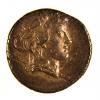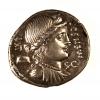You are here
Liberty’s Cap: The Origins of a Numismatic Symbol
The image of Liberty with her attributes of a cap (pileus) and staff (vindicta) go back to classical Greek and Roman conventions. The pileus originated in Greek iconography as the hat of the Dioscuri, the twin horsemen Castor and Pollux, sons of Zeus and the swan Leda. Their distinctive hats were the remnant of the eggs from which they were hatched. In the Roman Republic, during the ceremony of enfranchisement, a slave was touched with a special staff known as a vindicta and given a pileus to wear as a public sign of his freedom. The vindicta and pileus, separately and together, came to be a symbol of liberty and were used on the coins minted under the magistracy of various members of the families who opposed the Gracchi, Pompey, and Julius Caesar, and then later by Roman emperors as a sign of their commitment to the freedom of their subjects.
|
Louis Denis (1725–1794). “Carte du theâtre de la guerre présente en Amérique.” Paris: Basset, 1779. This French map of the progress of the American Revolution combines the allegorical images of America as a voluptuous Indian princess and Liberty with her staff and cap. |
|
Jacques Jonghelinck (1530–1606). Promulgation of the Perpetual Edict. Cast silver, 1577. The medal created to celebrate the removal of Spanish troops from the Netherlands marks the first appearance of Liberty in modern numismatics; her cap takes the form more of a contemporary hat than the classical pileus. |
|
Netherlands. Peace negotiations with France. Struck silver, 1745. The allegorical figure, who bears a caduceus (staff) as well as vindicta topped with a brimmed hat, is identified as Salus, or safety. |
|
Netherlands. Inauguration of William V of Orange and Nassau. Struck silver, 1766. By the period of the American Revolution, the cap on a shaft had become synonymous with the Dutch Republic, which was in fact governed by a hereditary Stadhouder. |
|
Philipp Heinrich Müller (1654–1719). Battle of La Hogue. Struck white metal with copper plug, 1692. This medal struck for a British naval victory over France adopts the depiction of Liberty used on Dutch medals. |
|
Benjamin Duvivier (1728–1819). Storming of the Tuileries. Struck bronze, 1792. In the iconography of the French Revolution, Liberty was often depicted with a pointed Phrygian cap rather than the egg-shaped pileus, a conflation that went back to classical times. |
The egg-shaped pileus hat of the Dioscuri is visible on the coins of Hellenistic Bactria (modern-day Afghanistan) from the second century BCE.
|
|
|
|
The temple dedicated to Jupiter and Libertas, shown on #3, had cult statues of both deities in equal proportion. On the other coins, Libertas is displayed with the pileus or vindicta or identified by name. Though the magistrates identified on the earlier coins are not the Cassius who assassinated Caesar, the family had a long commitment to anti-tyrannical causes, and the exact identification and chronology of these coins had not been established in the eighteenth century.
|
|
|
|
|
|
|
|
|
|
|
|
On the coinage of the Roman Empire, Liberty was depicted standing, holding her pileus to one side and, usually, the vindicta to the other.
|
|
|
|
|
|
Dutch coins bearing the cap on a staff circulated in the American colonies before the Revolution.





















